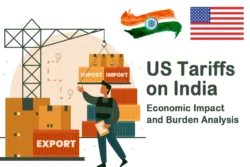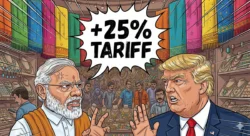Key Points
- Economic Growth: Research suggests that the 2025 tariffs, including a 10% universal tariff and higher rates on countries like China, Canada, and Mexico, have reduced US GDP growth by approximately 0.6 percentage points in 2025, with long-term effects potentially shrinking the economy by 0.3% annually.
- Inflation and Consumer Costs: Evidence leans toward tariffs increasing consumer prices, with estimates indicating a 1.5% rise in the short term, costing households around $2,000 annually. Specific goods like apparel and vehicles have seen significant price hikes.
- Employment: The tariffs appear to have increased unemployment slightly, with projections of 394,000 fewer jobs by the end of 2025, though some manufacturing sectors may see gains.
- Sectoral Impacts: While manufacturing output may grow modestly, agriculture and construction face declines due to retaliatory tariffs and higher costs, creating a mixed economic picture.
- Controversy: Supporters argue tariffs protect US industries and jobs, but many economists warn of higher costs, reduced efficiency, and risks of a global trade war, highlighting a contentious debate.
Economic Growth
The 2025 tariffs, implemented by the Trump administration, have likely slowed US economic growth. Studies estimate a reduction in real GDP growth by 0.6 percentage points in 2025, with a long-term annual loss of about $100 billion. This slowdown stems from reduced exports, weaker consumer demand, and trade policy uncertainty, which have dampened business investment and confidence.
Inflation and Consumer Prices
Tariffs have driven up prices for many goods, as importers pass on costs to consumers. Research indicates a 1.5% increase in the overall price level in the short term, translating to an average household loss of $2,000. For example, car prices have risen by about 11.4% due to a 25% auto tariff, and clothing prices have surged by up to 28%. This inflationary pressure has squeezed household budgets, particularly for lower-income families.
Employment and Jobs
The tariffs have had a mixed impact on jobs. While some manufacturing sectors may benefit, overall unemployment is projected to rise by 0.3 percentage points, with 394,000 fewer jobs by the end of 2025. Retaliatory tariffs from other countries have hit sectors like agriculture hard, offsetting potential gains in protected industries.
Controversy and Perspectives
The tariffs are a polarizing issue. The administration claims they protect American workers and industries, citing potential manufacturing growth. However, many economists argue that the costs—higher prices, reduced growth, and global trade tensions—outweigh these benefits. The debate remains heated, with concerns about long-term economic damage and the risk of a broader trade war.
Global Tariffs and Their Impact on the US Economy in 2025: A Comprehensive Analysis
In 2025, the Trump administration introduced a series of global tariffs aimed at bolstering domestic industries, addressing trade imbalances, and strengthening national security. These measures included a 10% universal tariff on all imports, 20% tariffs on Chinese goods, 25% tariffs on imports from Canada and Mexico, and targeted tariffs on sectors like automobiles and steel. While intended to protect American jobs and reduce reliance on foreign goods, these tariffs have sparked significant economic consequences, ranging from reduced growth to higher consumer prices. This article provides a detailed examination of their impacts, drawing on recent research from institutions like the Budget Lab at Yale, J.P. Morgan Research, and the Peterson Institute for International Economics (PIIE). It explores macroeconomic effects, sector-specific outcomes, fiscal implications, distributional consequences, global ramifications, and the broader debate surrounding these policies.
Overview of 2025 Tariffs
The 2025 tariffs represent an escalation of protectionist policies initiated during the 2018–2019 US-China trade war. Key components include:
- 10% Universal Tariff: Applied to all imports, increasing the cost of goods entering the US.
- 20% Tariff on China: Targeting a major trading partner to address trade deficits and intellectual property concerns.
- 25% Tariffs on Canada and Mexico: Affecting key North American partners, particularly impacting integrated supply chains like the auto industry.
- Sector-Specific Tariffs: Including 25% on automobiles and expanded tariffs on steel and aluminum.
The administration justified these measures as necessary to protect domestic industries, create jobs, and use trade policy as leverage for non-trade issues like migration and fentanyl smuggling. However, the tariffs have faced criticism for their economic costs, prompting a need for a thorough analysis of their effects.
Macroeconomic Impacts
GDP Growth
The tariffs have significantly slowed US economic growth. The Budget Lab at Yale estimates that real GDP growth in 2025 was reduced by 0.6 percentage points, with a long-run reduction of 0.3%, equivalent to $100 billion annually in 2024 dollars. J.P. Morgan Research projects 2025 real GDP growth at 1.6%, down 0.3 percentage points due to trade policy uncertainty and existing tariffs. The European Commission’s economic forecast suggests a GDP reduction of 0.6–1.0%, driven by falling exports and weaker domestic demand. The International Monetary Fund (IMF) further warns that a 10% universal tariff with retaliation could reduce US GDP by 1% through 2026, with half of this impact attributed to a sentiment shock from trade uncertainty.
Inflation
Tariffs have driven inflation by increasing the cost of imported goods, with a high pass-through rate to consumers. The Budget Lab reports a 1.5% short-run increase in the overall price level, equivalent to a $2,000 loss per household in 2025 dollars, settling at 1.3% ($1,700 loss) after substitution effects. J.P. Morgan notes that the average effective tariff rate rising from 10% to 23% could boost Personal Consumption Expenditures (PCE) prices by 1–1.5%, risking negative real disposable personal income growth in Q2–Q3 2025. Specific price increases include:
- Shoes: 33% higher in the short run, 18% long run.
- Apparel: 28% higher in the short run, 15% long run.
- Food: 2.2% higher in both short and long run.
- Motor Vehicles: 13.6% higher in the short run, 11.9% long run, adding $5,700–$6,500 to the cost of an average 2024 new car.
Unemployment
The labor market has experienced a modest but measurable impact. The Budget Lab projects a 0.3 percentage point rise in the unemployment rate by the end of 2025, resulting in 394,000 fewer jobs. Earlier studies, such as a 2024 analysis by David Autor and others, found that 2018–2019 tariffs had no significant positive effect on employment in protected sectors, while retaliatory tariffs harmed agricultural jobs. The 2025 tariffs follow a similar pattern, with losses in some sectors offsetting gains in others.
Sector-Specific Impacts
Manufacturing
While tariffs have spurred some manufacturing growth, with output expanding by 1.6% in the long run according to the Budget Lab, this comes at the cost of higher input prices and reduced global competitiveness. The PIIE highlights that durable manufacturing has been disproportionately hurt, with reduced output and employment due to supply chain disruptions and higher costs. Automation in manufacturing further limits job creation, tempering the benefits of tariff protection.
Agriculture
The agricultural sector has faced significant challenges due to retaliatory tariffs, particularly from China, which imposed an 84% tariff hike on US goods. The PIIE notes that US agriculture has been disproportionately affected, with reduced exports and higher input prices leading to a 1.1% long-run output contraction. This mirrors the 2018–2019 trade war, where agricultural exports suffered due to foreign retaliation.
Automobiles
The 25% tariff on imported automobiles, effective April 3, 2025, has significantly impacted the auto industry. J.P. Morgan estimates that this tariff could raise US light vehicle prices by 11.4%, contributing to a 0.2 percentage point reduction in 2025 GDP growth. The Budget Lab reports a 13.6% short-run price increase for motor vehicles, adding approximately $6,500 to the cost of a new car. This has led to plant closures and layoffs, with automakers like Stellantis announcing workforce reductions.
Other Sectors
Other sectors have also been affected. The Budget Lab notes a 3.1% long-run contraction in construction output due to higher material costs and reduced demand. Durable goods spending growth is expected to slow by 0.7% in 2025, according to Deloitte, as higher tariffs and interest rates dampen consumer spending. The highly integrated North American auto supply chain, where components cross borders multiple times, faces significant disruptions, increasing costs and delays.
| Sector | Short-Run Impact | Long-Run Impact |
|---|---|---|
| Manufacturing | +1.5–2.5% output, higher input costs | +1.6% output, reduced competitiveness |
| Agriculture | Reduced exports, higher input prices | -1.1% output |
| Automobiles | +13.6% prices, plant closures | +11.9% prices, job losses |
| Construction | Higher material costs | -3.1% output |
| Durable Goods | Reduced spending growth | -0.7% spending growth |
Fiscal Impacts
Tariffs have generated substantial revenue for the US government. The Budget Lab estimates that all 2025 tariffs will raise $2.3 trillion over 2026–2035 on a conventional basis, though negative dynamic revenue effects reduce this to $2.0 trillion. J.P. Morgan reports that duties generated $37.8 billion in April and May 2025 alone, with an average effective tariff rate of 23% raising approximately $400 billion annually (1.3% of US GDP). While this revenue could reduce federal debt, it comes at the cost of higher consumer prices and reduced economic efficiency.
| Fiscal Metric | Conventional Estimate | Dynamic Estimate |
|---|---|---|
| Revenue (2026–2035) | $2.3 trillion | $2.0 trillion |
| Negative Dynamic Revenue Effects | – | -$360 billion |
| Annual Revenue (2025) | $400 billion | – |
Distributional Effects
The tariffs have a regressive impact, disproportionately affecting lower-income households. The Budget Lab finds that the short-run burden on the first income decile is -2.8% compared to -0.8% for the top decile. Average annual costs are $1,100 for the lowest-income households, $1,900 for median households, and $4,200 for the highest-income households. Lower-income families, who spend a larger share of their income on goods, face a heavier relative burden, exacerbating economic inequality.
| Income Decile | Short-Run Burden | Annual Cost per Household |
|---|---|---|
| 1st (Lowest) | -2.8% | $1,100 |
| Median | -1.5% | $1,900 |
| 10th (Highest) | -0.8% | $4,200 |
Global and Geopolitical Implications
The tariffs have strained relations with key trading partners, prompting retaliatory measures that exacerbate economic losses. China’s 84% tariff hike on US goods, Canada’s projected 2.2–2.3% long-run economic contraction, and Mexico’s supply chain disruptions highlight the global fallout. The IMF and OECD warn of a potential global trade war, with trade volumes contracting by 5.5–8.5%. The tariffs are also used as leverage for non-trade issues, such as migration and fentanyl smuggling, complicating diplomatic negotiations and increasing geopolitical tensions.
Business and Consumer Sentiment
Business confidence has been significantly impacted by trade policy uncertainty. J.P. Morgan notes a sharp decline in business sentiment by mid-2025, leading to reduced investment and hiring. Consumer sentiment has also plummeted, with the University of Michigan’s index reaching a 28-month low in March 2025 as households anticipate higher prices. Financial markets have reflected this unease, with the S&P 500 down 17.4% and NASDAQ down 22.3% from mid-February to April 4, 2025.
Policy Responses and Mitigation Strategies
In response to the economic fallout, discussions about tariff reductions or exemptions have emerged. J.P. Morgan suggests that if International Emergency Economic Powers Act (IEEPA) tariffs cease, the effective tariff rate could fall to 5%, potentially boosting growth forecasts for the second half of 2025 and reducing core CPI by about 1%. Temporary tariff reductions, such as lowering US tariffs on China from 145% to 30% and China’s tariffs on the US from 125% to 10%, could further mitigate impacts if sustained. Additionally, a US-China deal on rare earths and magnets, announced on June 11, 2025, indicates some efforts to ease trade tensions.
Critical Perspectives
The tariffs have sparked a heated debate. Supporters, including the Trump administration, argue that they protect domestic industries, create jobs, and enhance national security, citing a 2024 study claiming economic growth and job creation. However, many economists and international organizations, including the IMF, OECD, and PIIE, counter that the costs outweigh the benefits. They point to historical examples like the 1930 Smoot-Hawley Tariff Act, which deepened the Great Depression, and argue that tariffs raise consumer prices, disrupt supply chains, and reduce economic efficiency. The limited employment gains in protected sectors, coupled with automation and global supply chain dynamics, further undermine the case for tariffs.
Conclusion
The 2025 global tariffs have had a profound impact on the US economy, reducing GDP growth, increasing inflation, and causing job losses in certain sectors. While they have generated significant revenue, the costs—higher consumer prices, reduced competitiveness, and strained global trade relations—pose substantial challenges. The regressive nature of the tariffs disproportionately burdens lower-income households, exacerbating inequality. As the US navigates these economic and geopolitical complexities, policymakers face the delicate task of balancing protectionist goals with the need for economic stability and global cooperation. The ongoing debate underscores the need for careful consideration of tariff policies and their long-term implications.
References
- Budget Lab at Yale. (2025). State of U.S. Tariffs: June 17, 2025. https://budgetlab.yale.edu/research/state-us-tariffs-june-17-2025
- J.P. Morgan Research. (2025). US Tariffs: Tracking the Economic Impact. https://www.jpmorgan.com/insights/global-research/current-events/us-tariffs
- Peterson Institute for International Economics (PIIE). (2025). The global economic effects of Trump’s 2025 tariffs. https://www.piie.com/publications/working-papers/2025/global-economic-effects-trumps-2025-tariffs
- European Commission. (2025). The macroeconomic effect of US tariff hikes. https://economy-finance.ec.europa.eu/economic-forecast-and-surveys/economic-forecasts/spring-2025-economic-forecast-moderate-growth-amid-global-economic-uncertainty/macroeconomic-effect-us-tariff-hikes_en
- New York Times. (2025, June 3). Trump’s Tariffs Will Drag Down the Global Economy, OECD Says. https://www.nytimes.com/2025/06/03/business/trump-tariffs-oecd.html







